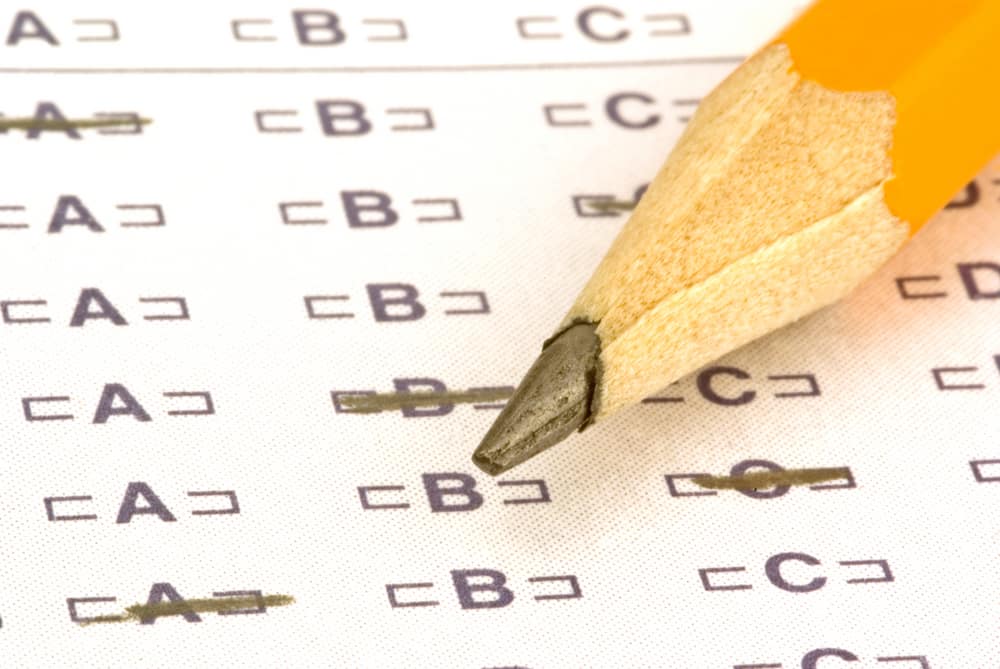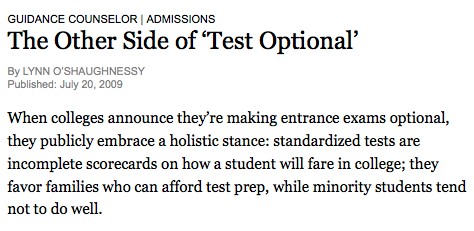
Students who perform poorly on the SAT or the ACT enjoy the option of applying to test-optional colleges and universities.
At schools that have embraced this policy, teenagers can typically apply to schools without having to submit their test scores, which can boost a teenager’s chances of getting into more prestigious schools.
This might sound great for students who struggle with the ACT and SAT, but are the students that schools say they are most eager to help actually benefiting from this policy? A fascinating new study suggests the answer is no.
A Primer on Test-Optional Schools
Before I share the research results, here is some background on test-optional policies:
There are more 850 schools that fall into the test-optional category. You can find the list of test-optional schools at FairTest.org. Many of these institutions are non-selective, which means that mediocre test scores most likely wouldn’t hurt an 
There are, however, elite schools which are test optional, particularly among liberal arts colleges. Liberal arts colleges evaluate applicants holistically and can spend more time with each application. More than a third of the top liberal arts colleges in the country are considered test optional. The latest to become test optional is Bryn Mawr, which made the announcement last week.
In contrast, universities, particularly state schools, rely heavily on statistics — GPA, test scores and class rank – to make admission decisions. Elite universities haven’t shown interest in going test optional. The most highly ranked university that switched to a test-optional policy is Wake Forest which spent a considerable amount of time changing its admission practices.
In adopting test-optional practices, institutions have said that they want to attract a more diverse student body. Standardized tests, after all, are highly correlated with income. A student with parents making $200,000 will, on average perform better on the SAT than a student whose family makes $150,000 and so on down the income ladder.
Who is Benefiting From Test-Optional Policies?
New peer-reviewed research from Andrew Belasco, the CEO of College Transitions, a college admissions consulting firm in Georgia, suggests that liberal arts colleges that adopted test-optional practices aren’t increasing their diversity numbers any more than their peers which still require the tests for admissions. (Belasco received his PhD at the University of Georgia’s Institute of Higher Education and was a recent fellow at the Association for Institutional Research.)
In the research, Belasco looked at 180 liberal arts colleges including 32 liberal arts colleges that are test-optional. The gains in enrollment of minority and low-income students were no different than the institutions that still require the SAT and ACT.
Belasco’s research suggests that the real beneficiary are the schools themselves that end looking more selective.
“Our findings suggest that test-optional admissions policies, as a whole, have done little to meet their manifest goals of expanding educational opportunity for low-income and minority students. However, we find evidence that test-optional policies fulfill a latent function of increasing the perceived selectivity and status of these institutions. In doing so, these policies may serve to reproduce and maintain the current social structure — and its inequalities — within U.S. higher education.”
Five years ago I wrote an article for The New York Times that explains how schools can appear to enroll brighter students by instituting a test-optional policy. I think that article is just as relevant today: The Other Side of Test Optional
I wrote a story about the new research last week for my college blog at CBS MoneyWatch. For that post I interviewed Bob Schaeffer at the Center for Fair and Open Testing (FairTest) and I have taken a snapshot of what he had to say in criticizing Belasco’s research and mentioning other test-optional research by William C. Hiss:
College Rankings and Test-Optional Policies
In an email to me, Schaeffer also made this argument regarding Belasco’s research:
“The authors imply that increased admissions selectivity, a result of the increase in applicants that comes from dropping test-score requirements, somehow benefits the schools at a time when selectivity is rising across the board. The implication is that this boosts the newly test-optional institution’s rankings. But Bob Morse, the director of the U.S. News & World Report ranking team, has repeatedly said that his analysis has found no pattern of ranking increases (or decreases) from adopting ACT/SAT optional policies. ”
Actually, it is extremely difficult to boost a school’s U.S. News’ ranking, but what Schaeffer didn’t mention is that, regardless of the rankings, affluent families are more likely to pay attention to published standardized test score ranges of individual schools and they like to aim for institutions that have generated more impressive test scores. Test-optional policies can artificially inflate published test scores because the applicants not submitting them will typically have earned lower scores.
Rich Students and Test-Optional
Meanwhile, Tony Bankston, who heads up admissions at Illinois Wesleyan University (a liberal arts college) and has followed the test-optional debate for years, suggested in an interview with me that the real beneficiaries of this test-optional policies are likely wealthy students.
“Everybody is struggling with enrollment, and colleges are looking more and more for students who have the ability to pay a substantial portion of college,” Bankston said. Test-optional policies open the door to take wealthy students who would have been borderline applicants. “I think a lot of this is going on behind the scenes.”
Diversity and College Admissions
I don’t think anyone is suggesting that underrepresented students haven’t benefited from test-optional policies, but the question is whether wealthy students and the institutions themselves are benefiting more.
Of course, the irony of these test-optional policies is that nothing is stopping institutions from accepting very good students with lower test scores anytime they want.
Read More…
Here is a story in Inside Higher Ed about Belasco’s research:
Test-Optional Policies Fail to Increase Low-Income Enrollment, Study Finds



Pingback: Is ACT and SAT Testing Required? – Capstone College Partners
Well at the “college fair” last week 9-15-14.
I posed the question. “What if I don’t have a straight A student – What options do I have to get him into school? I know that most of the schools boast that they have the ‘Top 10% in their class’ attending.”
I am in North Carolina so most of the schools were state schools including but not limited to Wake Forest University. They had five admissions coordinators on the stage answering questions.
Wake Forest was one of the speakers. And out of his mouth – “If your child is not making all A’s then he needs to stop all outside activities and concentrate on the grades. That is all we look at.” – I summed up. Also they still would prefer someone with a high SAT score. Just got that impression.
When all was said and done – we are looking at Louisburg College instead.
My son has fair grades a 3.0 unweighted and 3.6 weighted. Due to the lack of scholarship opportunities we will have to go to a smaller school with more financial aid opportunities also.
Three other issues:
– Test-optional schools often still require ACT or SAT scores for Merton-based aid, unless the merit scholarship is talent-based.
– The NCAA has a test score-GPA grid for athletic scholarships. Test-optional schools that okay scholarship sports must require the athletes to submit test scores.
– Colleges that participate in accelerated medical or law school admission programs still require ACT or SAT scores, even if the school is test optional. The medical school or law school partner requires the test.